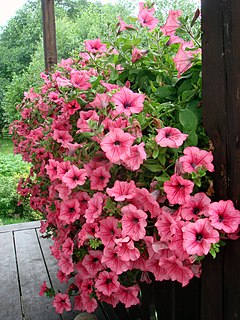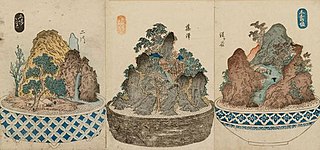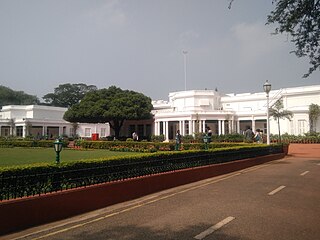
Bonsai is a Japanese version of the traditional Chinese art penjing or penzai. Unlike penjing, which utilizes traditional techniques to produce entirely natural scenery in small pots that mimic the grandiose shapes of real life scenery, the Japanese "bonsai" only attempts to produce small trees that mimic the shape of real life trees. Similar versions of the art exist in other cultures, including the miniature living landscapes of Vietnamese Hòn non bộ. It was during the Tang dynasty, when penjing was at its height, that the art was first introduced in Japan.

Ornamental plants or garden plants are plants that are grown for decorative purposes in gardens and landscape design projects. Many if not most are flowering plants, and garden varieties tend to be specially bred cultivars that improve on the original species in qualities such as colour, shape, scent and long-lasting blooms. There are many examples of fine ornamental plants that can provide height, privacy, and beauty for any garden. These ornamental perennial plants have seeds that allow them to reproduce. One of the beauties of ornamental grasses is that they are very versatile and low maintenance. All the main types of plant have many ornamental varieties: trees, shrubs, aquatic plants, perennial and annual plants. Non-botanical classifications include houseplants, bedding plants, plants for cut flowers and foliage plants. The cultivation of ornamental plants comes under floriculture and tree nurseries, which is a major branch of horticulture.

A rock garden, also known as a rockery and formerly as a rockwork, is a garden, or more often a part of a garden, with a landscaping framework of rocks, stones, and gravel, with planting appropriate to this setting. Usually these are small Alpine plants that need relatively little soil or water. Western rock gardens are often divided into alpine gardens, scree gardens on looser, smaller stones, and other rock gardens.

A conservatory is a building or room having glass or other transparent roofing and walls used as a greenhouse or a sunroom. Usually it refers to a space attached to a conventional building such as a house, especially in the United Kingdom. Elsewhere, especially in America, it can often refer to a large free-standing glass-walled building in a botanic garden or park, sometimes also called a palm house if tall enough for trees. Municipal conservatories became popular in the early 19th century.

Penjing, also known as penzai, is the ancient Chinese art of depicting artistically formed trees, other plants, and landscapes in miniature.
Hidden Lake Gardens colloquially known as Hidden Lake 755 acres (3.06 km2), is a botanical garden and an arboretum operated by Michigan State University situated in the Irish Hills of southeast Michigan. The Gardens are known for their large collection of native and nonnative trees, shrubs and flowers. HLG was given to Michigan State University by Harry Fee in 1945. Today it is visited by nearly 45,000 people annually. Hidden Lake Gardens mission is to "preserve and enhance the natural beauty of the gardens and to display plants for the inspiration and education of the public".

The Government Botanical Garden is a botanical garden in Udhagamandalam, near Coimbatore (Ooty), Tamil Nadu state, India laid out in 1848. The Gardens, divided into several sections, cover an area of around 55 acres, and lie on the lower slopes of Doddabetta peak. The garden has a terraced layout. It is maintained by the Tamil Nadu Horticulture Department.

A bonkei is a temporary or permanent three-dimensional depiction of a landscape in miniature, portrayed using mainly dry materials like rock, papier-mâché or cement mixtures, and sand in a shallow tray. A bonkei contains no living material, in contrast with related Japanese art forms bonsai and saikei: bonsai contain living trees, and saikei contain living trees and other vegetation.

The Conservatory of Flowers is a greenhouse and botanical garden that houses a collection of rare and exotic plants in Golden Gate Park, San Francisco, California. With construction having been completed in 1879, it is the oldest building in the park. It was one of the first municipal conservatories constructed in the United States and is the oldest remaining municipal wooden conservatory in the country. For these distinctions and for its associated historical, architectural, and engineering merits, the Conservatory of Flowers is listed on the National Register of Historic Places and the California Register of Historical Places. It is a California Historical Landmark and a San Francisco Designated Landmark.

The University of Michigan Matthaei Botanical Gardens includes botanical gardens, natural areas with trails, and several research-quality habitats. The conservatory is popular year round. The public entrance is at 1800 North Dixboro Road in Ann Arbor, Michigan. The grounds are open every day, but trails are not maintained in the winter. The conservatory, garden store, and lobby are open 7 days a week: Mon., Tues., and Thurs. - Sun., 10:00 am–4:30 pm; Wednesdays 10 am-8 pm. The building complex is only closed on three holidays a year. The institution's main web site with updated information is Matthaei Botanical Gardens.
This is an alphabetical index of articles related to gardening.

Carmona is a genus of flowering plants in the borage family, Boraginaceae. Members of the genus are commonly known as scorpionbush.

Rashtrapati Nilayam formerly known as Residency House is the official retreat of the President of India located in Hyderabad, Telangana, where the President stays for at least two weeks during winter and conducts official business. It is also used as a guest house for visiting dignitaries. It is located in Bollaram in Secunderabad, a neighborhood of Hyderabad. It was thrown open for public viewing from 1 January to 10 January, with entry being free.

Saikei (栽景) literally translates as "planted landscape". Saikei is a descendant of the Japanese arts of bonsai, bonseki, and bonkei, and is related less directly to similar miniature-landscape arts like the Chinese penjing and the Vietnamese hòn non bộ. It is the art of creating tray landscapes that combine miniature living trees with soil, rocks, water, and related vegetation in a single tray or similar container. A saikei landscape will remind the viewer of a natural location through its overall topography, choice of ground materials, and the species used in its plantings.

The JPMorgan Chase Building is an office building in San Francisco, California, 560-584 Mission Street, on the border between South of Market and the Financial District. Designed by architect César Pelli, the building stands 128.02 m (420.0 ft) and has about 655,000 square feet (60,900 m2) of office space. It also has two levels of underground parking and a large plaza. About 400,000 sq ft (37,000 m2) of the building is leased to the major tenant JPMorgan Chase. This is one of many new highrise projects completed or under construction on Mission Street since 2000.

Chrysanthemumbonsai is a Japanese art form using cultivation techniques to produce, in containers, chrysanthemum flowers that mimic the shape and scale of full size trees, called bonsai.

Indoor bonsai are bonsai cultivated for the indoor environment. Traditionally, bonsai are temperate climate trees grown outdoors in containers. Tropical and sub-tropical tree species can be cultivated to grow and thrive indoors, with some suited to bonsai aesthetics shaped as traditional outdoor or wild bonsai.

Bonsai cultivation and care involves the long-term cultivation of small trees in containers, called bonsai in the Japanese tradition of this art form. Similar practices exist in other Japanese art forms and in other cultures, including saikei (Japanese), penjing (Chinese), and hòn non bộ (Vietnamese). Trees are difficult to cultivate in containers, which restrict root growth, nutrition uptake, and resources for transpiration. In addition to the root constraints of containers, bonsai trunks, branches, and foliage are extensively shaped and manipulated to meet aesthetic goals. Specialized tools and techniques are used to protect the health and vigor of the subject tree. Over time, the artistic manipulation of small trees in containers has led to a number of cultivation and care approaches that successfully meet the practical and the artistic requirements of bonsai and similar traditions.

Bonsai is a Japanese art form using trees grown in containers. Similar practices exist in other cultures, including the Chinese tradition of penjing from which the art originated, and the miniature living landscapes of Vietnamese hòn non bộ. The term "bonsai" itself is a Japanese pronunciation of the earlier Chinese term penzai. The word bonsai is often used in English as an umbrella term for all miniature trees in containers or pots. This article focuses on the history of bonsai in Japan and, in modern times, worldwide.
George Sherman Avery, Jr. was an American botanist, expert on plant physiology, and prominent horticulturalist.


















